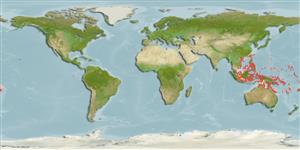>
Ovalentaria/misc (Various families in series Ovalentaria) >
Pomacentridae (Damselfishes) > Pomacentrinae
Etymology: Neopomacentrus: Greek, neos = new + Greek,poma = cover, operculum + Greek,kentron = sting (Ref. 45335).
More on author: Bleeker.
Environment: milieu / climate zone / depth range / distribution range
البيئة
بحري مرتبطة بالشعاب; غير مهاجرة; نطاق العمق 1 - 30 m (Ref. 1602). Tropical; 25°N - 21°S
Western Central Pacific: Indonesia to Solomon Islands, north to Japan, south to northern Australia and Vanuatu.
الحجم / وزن / العمر
Maturity: Lm ? range ? - ? cm
Max length : 7.5 cm TL ذكر/ مختلط الجنس; (Ref. 48636)
وصف مختصر
الوصف الخارجي | قياسات المظهر الخارجي
الأشواك الظهرية (المجموع): 13; الأشعة الظهرية الناعمة (المجموع): 11-12; شوكة شرجية 2; أشعه شرجية لينه: 10 - 11.
Adults are found in lagoons, harbors, and coastal reefs, shallow habitats, deep sand or mud slopes with outcrops of debris or coral rubble pieces, or on rocky substrates in sheltered bays. They usually occur in large aggregations, sometimes forming mixed aggregations with Neopomacentrus sp. Abundant around sponge-encrusted mooring buoys and their anchor lines and occur in smaller colonies around rocks and refuse (Ref. 1602). Oviparous, distinct pairing during breeding (Ref. 205). Eggs are demersal and adhere to the substrate (Ref. 205). Males guard and aerate the eggs (Ref. 205). Diurnal species (Ref. 113699).
Life cycle and mating behavior
النضج | التكاثر | وضع البيض | بيض | الخصوبة | Larvae
Oviparous, distinct pairing during breeding (Ref. 205). Eggs are demersal and adhere to the substrate (Ref. 205). Males guard and aerate the eggs (Ref. 205).
Allen, G.R., 1991. Damselfishes of the world. Mergus Publishers, Melle, Germany. 271 p. (Ref. 7247)
IUCN Red List Status (Ref. 130435)
استخدامات بشرية
مزيد من المعلومات
مراجعالأستزراع المائيملف الأستزراع المائيسلالاتجينيElectrophoresesالتوريثالأمراضمعالجةNutrientsMass conversion
أدوات
تقارير خاصة
Download XML
مصادر علي الأنترنت
Estimates based on models
Preferred temperature (Ref.
123201): 26.1 - 29.3, mean 28.7 °C (based on 1965 cells).
Phylogenetic diversity index (Ref.
82804): PD
50 = 0.5000 [Uniqueness, from 0.5 = low to 2.0 = high].
Bayesian length-weight: a=0.01514 (0.00687 - 0.03334), b=2.99 (2.80 - 3.18), in cm total length, based on LWR estimates for this species & (Sub)family-body (Ref.
93245).
مستوى غذائي (Ref.
69278): 3.4 ±0.45 se; based on food items.
المرونه (Ref.
120179): عالي, الحد الزمني الأدني لتضاعف عدد أفراد المجتمع أقل من 15 شهر (Preliminary K or Fecundity.).
Fishing Vulnerability (Ref.
59153): Low vulnerability (10 of 100).
Nutrients (Ref.
124155): Calcium = 142 [84, 273] mg/100g; Iron = 1.02 [0.63, 1.66] mg/100g; Protein = 18.6 [17.6, 19.6] %; Omega3 = 0.169 [0.098, 0.289] g/100g; Selenium = 21.1 [11.4, 41.2] μg/100g; VitaminA = 245 [87, 671] μg/100g; Zinc = 1.94 [1.32, 2.75] mg/100g (wet weight);
